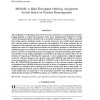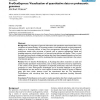BMCBI
2004
13 years 11 months ago
2004
Background: The genomes of an increasing number of species are being investigated through generation of expressed sequence tags (ESTs). However, ESTs are prone to sequencing error...
BMCBI
2004
13 years 11 months ago
2004
Background: A number of completely sequenced eukaryotic genome data are available in the public domain. Eukaryotic genes are either 'intron containing' or 'intronle...
BMCBI
2004
13 years 11 months ago
2004
Background: Computational gene prediction continues to be an important problem, especially for genomes with little experimental data. Results: I introduce the SNAP gene finder whi...
BMCBI
2004
13 years 11 months ago
2004
Background: In addition to known protein-coding genes, large amounts of apparently non-coding sequence are conserved between the human and mouse genomes. It seems reasonable to as...
BMCBI
2004
13 years 11 months ago
2004
Background: All known genomes code for a large number of transcription factors. It is important to develop methods that will reveal how these transcription factors act on a genome...
JDA
2007
13 years 11 months ago
2007
In the median problem, we are given a distance or dissimilarity measure d, three genomes G1, G2, and G3, and we want to find a genome G (a median) such that the sum 3 i=1 d(G, Gi...
JCB
2007
13 years 11 months ago
2007
The assignment of orthologous genes between a pair of genomes is a fundamental and challenging problem in comparative genomics, since many computational methods for solving variou...
BMCBI
2005
13 years 11 months ago
2005
Background: The integration of genomic information with quantitative experimental data is a key component of systems biology. An increasing number of microbial genomes are being s...
BMCBI
2005
13 years 11 months ago
2005
Background: Clone-based microarrays, on which each spot represents a random genomic fragment, are a good alternative to open reading frame-based microarrays, especially for microo...
BMCBI
2005
13 years 11 months ago
2005
Background: The availability of the human genome sequence as well as the large number of physically accessible oligonucleotides, cDNA, and BAC clones across the entire genome has ...




